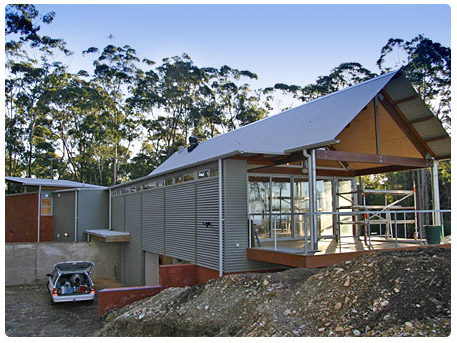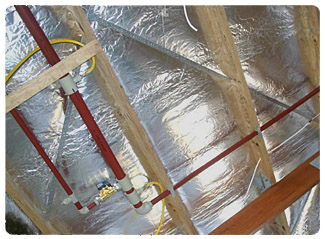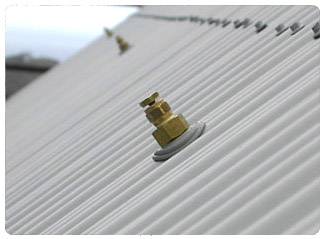Bill Griffin knew that his new family home near
So Professor Griffin- a professor in the Department of Earth and Planetary Sciences at
“We made sure that the house itself was relatively fire resistant, however we installed the CalAir Fire-Pro system to provide an extra level of protection,” says Professor Griffin.
 Activated by low-voltage heat detectors as temperatures rise to danger levels, CalAir Pipe Systems says its Fire-Pro EWSS (External Water Spray System) is Australia’s first professionally designed and manufactured bushfire protection system for new and existing houses.
Activated by low-voltage heat detectors as temperatures rise to danger levels, CalAir Pipe Systems says its Fire-Pro EWSS (External Water Spray System) is Australia’s first professionally designed and manufactured bushfire protection system for new and existing houses.
The system was installed at Professor Griffin’s new 310 sq m residence by South Coast Builder Mark Green of M and J Green Builders, Greensmart Professionals, who said this, his first installation of the system, went very smoothly. With the large number of acreages in the area and
Professor Griffin says “We chose the CalAir system because it seemed to be more professionally designed and produced than any of the alternatives we were able to find. It was also more economical than at least one other system we looked at – and that one that would not have had as good coverage.”
Designed for unobtrusive built-in installation for protection without ugliness, all of the system’s major components are located within the roof space. Low-profile Roof Mist (RMI) and Eave Drencher (EDI) spray nozzles - especially designed for weather tight installation – merge with eaves and rooflines to provide blanket coverage of external areas posing greatest risk. The RM1 nozzles protect against flying embers on roofs and gutters while ED1 nozzles protect windows and doors.
“We were impressed with the way in which CalAir handled any difficulties which arose,” says Professor Griffin. “Our roof is pitched in several different directions and we have cathedral ceilings which means there is no roof space. This made the installation more difficult than in an ordinary house; however CalAir Managed this issue very well.
 “They have also been very helpful with post-installation training, giving us some very impressive demonstrations.”
“They have also been very helpful with post-installation training, giving us some very impressive demonstrations.”
Mark Green says the CalAir system compared very strongly with copper or gal systems for cost and ease of installation – “It made a lot of sense, especially in this unique home with a lot of steel in the roof. I can see it having further uses in districts like this.”
CalAir Managing Director John McNab says the EWSS system – distribution of which is being expanded nationally - is designed for safe and practical installation in rural and urban areas.
Drawing water from either swimming pools or dedicated tanks, the system comes complete with pipe and pipe fittings, hose assemblies, spray nozzles, valves, heat detectors and with pumping equipment from industry leader Davey Pumps.
CalAir spray nozzle designs provide optimum droplet size at minimum flow and pressure to avoid early depletion of water supplies. The system automatically shuts down when temperatures drop below danger level.
The result of several years’ development by CalAir - which has installed more than 6500 of its industrial and commercial long-life polymer liquid and gas piping systems since 1988 - Fire-Pro EWSS is designed for DIY installation or by CalAir personnel in NSW,
“Compared with the loss, devastation and personal risk of current methods of fire protection – which rely on householders and fire personnel exposing themselves to extreme danger - this is a very cost-effective investment. It is also designed to be easy to install during building or to retro-fit,” said Mr McNab.
The system’s easily installed piping - made from an advanced polymer containing flame retardants - is eight times lighter than traditional galvanized steel piping, will not corrode either internally or externally, and does not require specialist labour or welding.
Major advantages of the CalAir system include safe installation without having to walk on the roof. The pipe system’s ring main is installed within the roof cavity without specialist tools. Industrial grade flexible hosing carries water to nozzles projecting outside where they cover hazard areas.
In addition to not having ugly pipelines covering roofs, the CalAir system prevents damage resulting from installers or inspectors walking upon them. The system is installed from within the roof cavity.
 “People just don’t realize what it costs to clean up a site and get it ready for a rebuild or a renovation, or the repairs that are necessary when a fire comes through.
“People just don’t realize what it costs to clean up a site and get it ready for a rebuild or a renovation, or the repairs that are necessary when a fire comes through.
“Householders all to often fail to take into account the costs of demolition, removing debris from their property, rebuilding costs such as architects fees, and recent improvements that could alter a building’s value. When people put all that time into getting a property to the stage where they’re very comfortable in it, a fire can be a disaster.”
Professor Griffin says he has no problem recommending the CalAir system to any homeowners who want certainty and security in a potentially bushfire-prone setting.
For details about CalAir’s national network, please contact Mr John S. McNab, 6 Edwards Road, Dural, NSW 2158, Australia, Ph:(61+2) 9651 4722, website www.calair.net.au, email sales@calair.net.au
